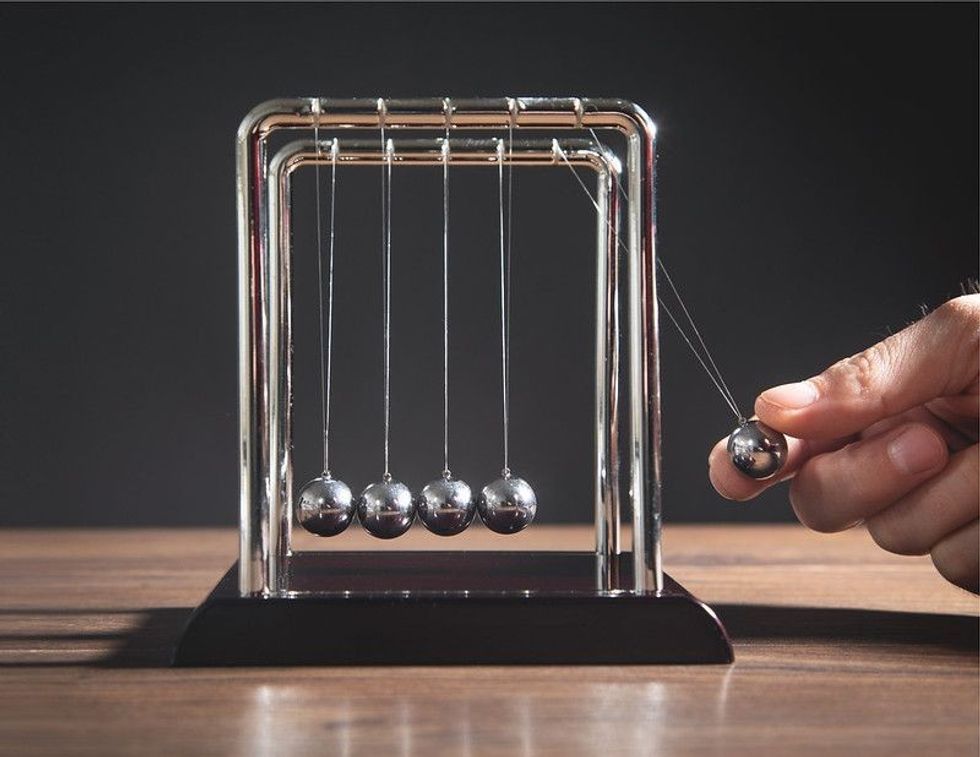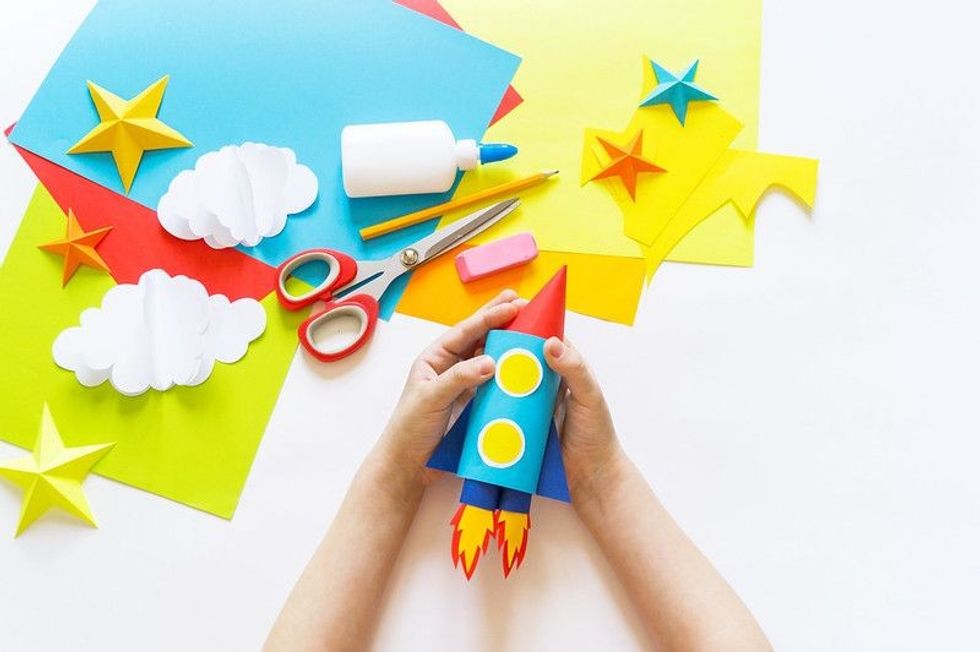One of the secrets to homeschooling is variety, and getting teens away from the books and doing something practical is ideal. It makes it easier to learn the theory and if your teen is a visual or kinetic learner, doing something practical is preferable to reading a book.
Here are science experiments and projects that should inject some fun into home science. We have tried to include experiments that use items you are likely to already have at home.
1. Make a silver egg
Your teens will have probably made rubber eggs, and carried out the egg drop challenge. But have they done this science experiment to turn an ordinary chicken egg into a silver egg?
What you need:
- Candle
- Lighter
- Raw egg
- Jar or container of water
- Tongs
Method
Light a small candle or tealight, then move the egg around over the flame until the whole egg is covered in soot. Once you have a good sooty coating, gently place it in the jar of water. Look at the egg through the side of the jar and you will see it looks like mercury glass.
2. Make plastic polymers from milk
You will need
- Milk
- Vinegar
- Bowl
- Spoon
- Sieve
- Cookie cutters
Method
Add a pint of milk to a saucepan and heat it until it is hot but not boiling, then carefully pour it into a bowl. Add some vinegar to the milk and then stir it around until you see blobs forming in the bowl. Next, strain the milk through a sieve.
You will be left with a mass of blobby lumps. Leave to cool a little and then rinse with water.
Press all the blobs together to form a 'dough' and squeeze out the liquid. Flatten out onto a smooth surface and then cut out shapes with a cookie cutter. Leave to harden over a couple of days.
The science part
What you have actually made is casein, which is made when the milk's proteins meet the acid in the vinegar. the casein will not mix with the acid, so it forms the blobs you strained out.
3. How does temperature affect the rate of diffusion?
Useful for practising recording results in science experiments.
You will need
- Food dye
- Small wide glass, lid or petri dish if you have it
- Dropper/pipette
- Thermometer
- Stopwatch or smartphone
- Squared paper
Method
Fill the glass or dish with cold water. Measure the temperature. Place the container on squared or graph paper. Add a drop of food dye into the centre (if you have a proper pipette, measure out 1cm3).
Set the stopwatch for 1.5 minutes. Measure how much of the dish the dye has spread to using the graph paper as your guide. Repeat using lukewarm water and then using hot water.
The science part
Record all your measurements and then create a graph to show them. Explain what you have discovered about the effect of water temperature on the rate of diffusion. Think about what other factors could affect the rate of diffusion.
4. Build a rocket

Even the coolest teens should enjoy this!
You will need
- Bottle of water
- Snap top canister - film canister, fizzy vitamin C tablet tube, Smarties tube
- Alka Seltzer tablets
- Cardboard/hot glue (if you are making a rocket frame)
- Safety glasses/goggles
Method
Build a rocket frame from the cardboard. Add water - this is your fuel - to the canister. Drop an Alka Seltzer tablet (the oxidiser) into the canister, quickly add the lid and step back before blast off.
The science part
The explosion is caused by mixing an acid and a base, making carbon dioxide. Measure how high the rocket flies. Experiment with using more or less fuel and more or less oxidiser.
5. Solve a crime
Fans of TV shows such as CSI will enjoy delving into the world of forensic science by learning how to take fingerprints.
You will need
- Microscope slide
- Fingerprint powder or any fine powder (talcum powder, cornflour, or cocoa powder)
- Small brush with very soft bristles
- Clear sticky tape
Method
Touch the slide or glass with your fingers to leave some prints (you can moisturise hands first to leave more residue). Sprinkle your dusting powder on the slide, and gently brush off.
Stick the tape over the fingerprint and lift it up - this should leave the print on the tape. Stick to a darker piece of paper to keep a record of the print.
The science part
Take fingerprints of family members. Colour on a piece of paper using a graphite pencil, then get each person to rub their finger in pencil and then roll their finger over the tape. Keep records of the prints and then try to identify them from objects around the home, such as doorknobs and handles.
6. Measure how heart rate changes with exercise
Find out which of your favourite forms of exercise is keeping your heart healthy.
You will need
- A smartphone or tablet
- Google's Science Journal app or an activity tracker, like a Fitbit
- Some energy for doing the exercise!
Method
Devise five different activities, for instance, running around the garden, jumping upstairs, going for a brisk walk, shooting some hoops or scoring goals, doing 20 star jumps. Use the Science Journal app or FitBit to visualise your heart rate, or your activity tracker to measure it and find out which activity makes your heart beat faster.
The science part
Alter the length and rate of the exercises to see how that affects your heart rate.
7. Extract your own DNA
You will need
- Small paper cups
- Bottle of sports drink or a strong saltwater solution
- Washing up liquid (preferably colourless or very light)
- Pineapple juice
- Wooden skewer
- Surgical spirit
- Food colour
- Narrow container with a lid
Method
Put the surgical spirit in the freezer 24 hours before you start. Put 500ml water into a cup and add a tablespoon of salt or use the sports drink.
Gargle the water and spit into a cup, Add some washing up liquid and a few drops of pineapple juice. Mix together gently.
Then carefully pour the alcohol mixed with food colouring down the side of the glass so that it sits on top of the sports drink or saltwater mixture. You should be able to see the DNA floating in the alcohol - you can extract it by winding around the skewer.
The science part
Pineapple juice contains enzymes that help to break down the cell membrane. Try extracting DNA from fruits such as bananas, or vegetables such as spinach.
8. Make a vegetable pH indicator
Did you know you can use red cabbage as a pH indicator?
You will need
- Red cabbage
- Knife or food processor
- Boiling water
- Coffee filter
- One large glass or jar
- Six smaller glass jars
- Household solutions such as baking soda, washing powder, lemon juice etc
- Safety glasses/goggles and gloves.
Method
Cut the cabbage into small pieces. You need about two cups full. Place in the large beaker and cover with boiling water. Leave for around 10 minutes until the colour begins to leach out.
Use a sieve to get rid of the cabbage parts and leave you with a red-purple liquid. This liquid will be about pH 7. Divide the liquid between the six smaller glasses and then add a different household solution to each one to test its pH level.
The science part
The resulting colour of the liquid will show you the pH level Red - pH 2, purple pH 4, blue-purple pH 6, Blue, pH 8, Blue-green pH 10 and greeny yellow pH 12. Try making your own litmus paper by soaking strips of coffee filter paper in the red cabbage juice. Dry before use.
9. Make a fire extinguisher
Learn how to put out candles with this clever trick.
You will need
- White vinegar
- Sodium bicarbonate
- Candles or tea lights
- Container or trough
- Large jug
Method
Light the candles and place in a trough or container, put the sodium bicarbonate in a jug and add the vinegar, then 'pour' the resulting gas over the candles to extinguish them.
The science part
The carbon dioxide is released by the endothermic reaction in the jug.
10. Bend water
Discover how you can 'bend' water with this cool science trick.
You will need
- A bottle or a cold water tap
- A piece of plastic pipe
- A piece of nylon - tights or similar
Method
Pour a stream of water out of a bottle or turn on the tap. Charge up the plastic rod by rubbing with the nylon material. Then bring the rod up close to the water stream - don't touch it though. As the rod gets close, the stream of water will bend towards it.
The science part
The rod is charged up with static electricity, which can attract the water stream.
11. Make a sky in a glass
Demonstrate why the sky is blue and sunsets are orange.
You will need
Method
Fill the glass with water, and add a teaspoon of milk. Stir well. Take into a dark room.
Shine the torch on the glass from above - it should look blue. Then shine the light through the side of the glass - it should look reddish, Finally, shine the light up through the base and look down into the water from the top. The water should be a deeper red.
The science part
The milk particles behave as dust particles do in the atmosphere, scattering light waves.
12. Make a metal ball
This could take a while!
You will need
- Tinfoil
- Sanding block
- Hammer
- Polisher
Method
Make a ball out of tinfoil. Hammer it into shape and keep adding extra layers. When you have a decent-sized, solid ball, use a sanding block to polish it. You can keep on polishing it - use a polishing plate on an electric drill if you have one.









